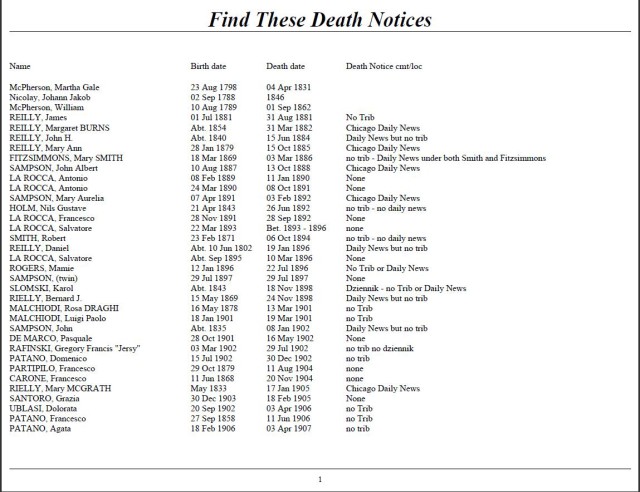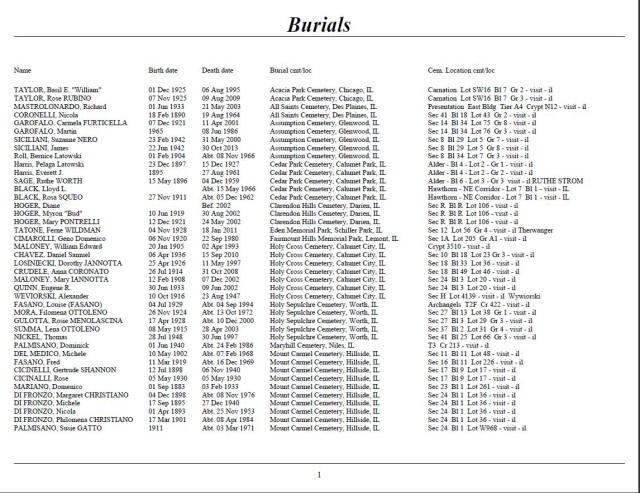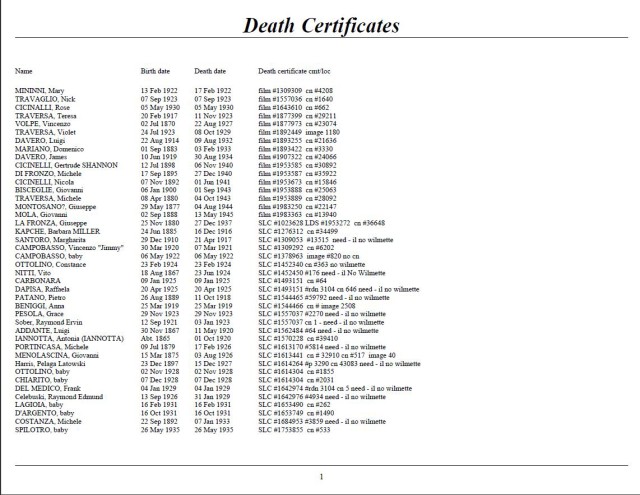When you begin your genealogical journey, two possibilities can happen. One is that you focus like a laser beam on a single person and do whatever you can to find everything you need about that one individual. The second possibility is the one that usually happens to everybody! Once you ask for the names of your grandfather’s brothers and sisters and THEIR kids, you have a lot of people and a lot of data to find for each of them, and it can be overwhelming, if you’re not organized.
Everybody organizes their lives in different ways. There is no one way to do it. But we all know people who seem to coast on the wave of life and deal with situations as they happen and somehow it all works out for them. Other people need to plan things to the last detail, in order to prepare for the possibility that something will go wrong. The point is, whatever method works for you, you should use that method to organize your genealogy research.
I have a data file of nearly 77,000 relatives now, the result of 25 years of work. For each relative, I need basic information. I need their birth date and city of birth. For those who have married, I need the name(s) of their spouse(s), and date(s) and place(s) of the marriage(s). If they are deceased, I need the date and place of their death, and the cemetery name and burial or entombment location. To keep things simple, let’s skip other details such as immigration, citizenship or military service that do not apply to everyone.
With so many different pieces of data that can apply to so many people, how can one keep track of it all? The research process requires that we keep track of several items for each piece of data we are researching.
1) We need to know what we need to look for and where it is.
2) We need to know what we have searched and failed.
3) We need to know what we found.
It sounds very basic, but if we do not keep track of these three simple issues, we will waste a lot of time looking in the same place for the same data. One of the most compelling reasons to use family tree software such as Family Tree Maker or Roots Magic is to have a place to keep track of these three questions.
Logically, if I need to find a primary source, I need to know A) what the source is, B) where I can find it and C) if I’ve already tried and failed. So I use the tools such as genealogical websites to find out what sources I can use, and where I can find the actual records. In many cases, the websites may direct me to a digitized copy of the original source, which I can download and save. This reduces the workload by quite a bit. However, in many cases, I may have to find my original source on microfilm.
Let’s say that I am new at research and I found a death notice for my great-grandfather. This death notice lists all his children. I did not have all their names before, especially since the ones I met were all known to me by nicknames like “Uncle Twain” and “Oo-Moosh” And “Nonna,” so I need Nonna’s actual name. So I found out that my great-grandparents had seven children who lived to adulthood. I now need sources for all the questions listed above, for each of the seven children.
I need a birth certificate for each of the seven siblings. No matter what else happened, they all have “birth” in common. Where do I look? Let’s presume that no one told me which of the seven children was born in Chicago and which were born in Italy? So I search the Cook County birth certificate index on familysearch.org. None of the certificates are online directly, but I can either order them online through cookcountygenealogy.com or I can try to find them in the microfilm collection at the Wilmette Family History Center. Well, I searched for all seven siblings and I did not find a birth certificate for Joe, Connie, Nick, Dominick or Tony. I did find birth certificates for Frances and Mary. Both can be found on microfilm at Wilmette and the birth certificate index tells me which microfilm number and which certificate number they are.
Having done all this, I need to log what I learned in my family tree file. I use a field called “Birth Certificate.” I could type what I learned in a generic “Notes” section, but it will be very difficult to print a report of my findings for later, because the notes can contain anything. If I use a specific field for each piece of data, I can list what I need and what I failed to find that is specific only to that piece of data. So I go to each sibling’s record in my family tree file and type the following in the field called “Birth Certificate”:
• Joe: not found in Cook County births on familysearch
• Connie: not found in Cook County births on familysearch
• Nick: not found in Cook County births on familysearch
• Dominick: not found in Cook County births on familysearch
• Tony: not found in Cook County births on familysearch
• Frances: film #1234567 cn #34543
• Mary: film #1322887 cn #45271
So I know that I tried and failed to find five of the siblings, and I have to locate microfilm for two of them. As a beginning genealogist, I might not know that not everyone in Chicago has a birth certificate because they weren’t required until 1916. Just because they could not be found in Cook County does not mean they were born elsewhere. So I ask my local genealogy buddies and they tell me to check the U.S. Census records to find the birthplaces of all seven siblings. I searched the 1910 census and the family is not there at all. I searched 1920 and I found my great-grandparents with everyone except Mary. The five who were not in Cook County were born in Italy. Ater some checking, I find out the name of the town they were born in. Then I find out that there are microfilms of that town.
With this new information, I change the “Birth Certificate” fields in my family tree file. I really don’t need to retain the information that they were not found in Cook County births, because I now know they weren’t born here. I wouldn’t bother to record “not found in Akron Ohio births” either, unless I had some reason to believe they were born there and I should pursue the records there. When you are keeping track of the places you have searched and failed, you can’t list every place. It would look like “Not in Akron, Chicago, Sheboygan, Tokyo, Madagascar, etc.” Just list the reasonable ones that might be true based on your research findings.
So I change the birth certificate fields:
• Joe: film #1648932 1898 Triggiano births
• Connie: film #1648932 1901 Triggiano births
• Nick: film #1648935 1903 Triggiano births
• Dominick: film #1648938 1905 Triggiano births
• Tony: film #1648942 1907 Triggiano births
I now have six different microfilms (two of the siblings are in the same film) to look for the birth certificates of the seven siblings. How does this all matter when it comes to organization? It matters because you have a list of films that you need to look at, and not every film is at every center. Even Salt Lake City does not have every film on shelf. So you keep a list of these films at the ready for when you can get to the Wilmette Family History Center. There is no guarantee that they will have the Triggiano birth films but it is always worth checking.
Now that I have a list of births to find, I move on to marriages. I search for all of them and only find one marriage license on microfilm. I make a field called “Marriage License.”.Two of them died young and never married, so I leave it blank. The one I found, I type “film #” just like the birth certificates. The other four, I type “not found in Cook County marriages on familysearch”.
Why do I use a separate field for birth certificates and marriage licenses? It tells me WHAT I am searching for, keeping me focused on births or marriages, or indeed, deaths.
So now I have possibly seven birth certificates and a marriage license I can try to find in Wilmette. Let’s make it worth the drive and try to find death certificates. I search for everyone but Mary, who is very much alive. I found two death certificates in the index for the two brothers who died young. So I mark the field “Death Certificate” with “film #” and the microfilm number I found in the index, plus the certificate number so I know which record to find.
After all this work, I have five birth certificates in Italian records, two birth certificates in Cook County microfilm, one marriage license in Cook County microfilm, and two death certificates in Cook County microfilm. If I choose to take a trip to Wilmette, I have five Cook County and five Italian records to attempt to find on microfilm, all in one visit. This is what I am talking about regarding organization. I have consolidated my research to gather up data from many people and drive one time to a location where original sources are kept.
In the process of looking for all these people, there are additional people I should be looking for.
• Joe’s wife, Josephine
• Connie’s husband, Jimmy
• Dominick’s wife, Helen
• Frances’ husband, Patrick
• Mary’s husband, Joe
I already looked at the marriages and only found Connie and Jimmy. But I haven’t looked for births or deaths for any of these people yet. So I search the same indexes and find birth certificates for three of the five spouses, plus one death certificate. This is great! Now I can go to Wilmette ONCE, and find three death certificates, a marriage license, and five birth certificates! Can you imagine how much you could find if you also did all these searches for your OTHER great-grandparents? You have four sets of great grandparents who all had kids. If I started my research today, I would have the following additional people:
• Stella, (Helen is my grandma), John, Joseph, Alice, Daniel, Katherine and Eleanor
• Joseph, Mary (and Anna is my other grandma)
• Michael, Mary, (Walter is my other grandpa), Andrew, Caroline and Jacob
So after searching for all of these grand-aunts and -uncles, I found:
• Birth certificate microfilm and certificate numbers: John, Joseph, Alice, Daniel, Katherine, Eleanor, Jacob
• Marriage license numbers and microfilm numbers: none!
• Death certificate numbers and microfilm numbers: only Stella
I would mark the ones I found with “film # and cn #”. I would mark the rest with “not found in Cook County index on familysearch”.
Now I am driving to Wilmette with a list of 10 Cook County birth certificate films, one marriage license film, and four death certificate films. Those are expected to be there. The Italy films are probably not there but I bring my list anyway just in case.
So far, we have 19 records to find in microfilms, and a lot of people not found. We need to make sure we have all of them updated in our family tree file. There are 28 people so far (and we didn’t try to include the spouses of the additional people we just added!), and we need to update the birth certificate, marriage license, and death certificate fields in our family tree file.
So we print our reports and go to Wilmette. We can bring our laptop, too, if we want. The Italy birth films are not at Wilmette, as expected. However, we also failed to find the microfilm for two of the certificates. For whatever reason, Wilmette doesn’t have them.
Now what do we do to record what we found, and what we didn’t find? I have a simple system that works for me. Maybe you want to tweak the system to your own taste, but I have to keep track of my microfilm research using the following method.
If I have not yet looked at a film, I put “film #1234567” in the field. I search local family history centers for these films, especially Wilmette.
If I have looked for the film and the local centers do not have it, then I need to either order the film from Salt Lake City, or I need to wait until I travel to Salt Lake City to work with it. So I change the field to be “SLC #1234567”. This way I can retrieve ONLY the SLC films, or only the “film” films. The next time I go to Wilmette, I don’t need to print the list of SLC films because I already looked for these.
If I found the record I need on a microfilm, I change the field to “LDS #1234567” which means I found it on LDS (Latter Day Saints) microfilm number 1234567. I don’t want to look for this again because I already found it.
When I am ready to order new microfilms from Salt Lake City, I create a report and include individuals “Birth Certificate” contains “SLC #” and leave the film number off. I want EVERY film that I have not found yet. I print that report. Then I do another report for Marriage License contains “SLC #” and the same for Death Certificate. I will have lists of the films I need to either order from Salt Lake or work with when I visit there. The critical component of this method is that I always update my fields after concluding a research trip. When I get home from Wilmette, I need to mark my fields with the LDS or SLC depending on whether I found them or not. If I didn’t look because I ran out of time, don’t change the field. It’ll be there when I go the next time.
In summary, we need to keep track of our three questions.
1) We need to know what we need to look for and where it is: Change the field to “film #” and wait until visiting a local family history center.
2) We need to know what we have searched and failed: If no microfilm exists for this record, change the field to “not available on familysearch.” If a film exists but is not locally available, change the field to “SLC #” and order from Salt Lake City.
3) We need to know what we found: Change the field to “LDS #” so we don’t look for it again.
The best part of all this is that the field acts as your source. When someone wants to know how you found that birth data, you have a microfilm number and a certificate number readily visible in your family tree file with that person.
You can use this method for keeping track of finding the cemetery location, passenger list, military service (draft cards), census records, citizenship petition, or anything else that you feel compelled to find about each of your relatives.
Before we close, keep one thought in mind. Imagine that we choose to NOT keep track of this with these fields. How would you know to go to Wilmette? How would you know who to look for when you’re there? Which film numbers do you need? Which certificate numbers are you looking for? Which ones have you already tried to find and failed? You would end up having to look up these records while you’re there, which wastes valuable research time you could have done while you were at home.
See the following screen captures for examples of my notation system.
Write to Dan at italianroots@comcast.net and please put “Fra Noi” in the subject line.
 Fra Noi Embrace Your Inner Italian
Fra Noi Embrace Your Inner Italian









